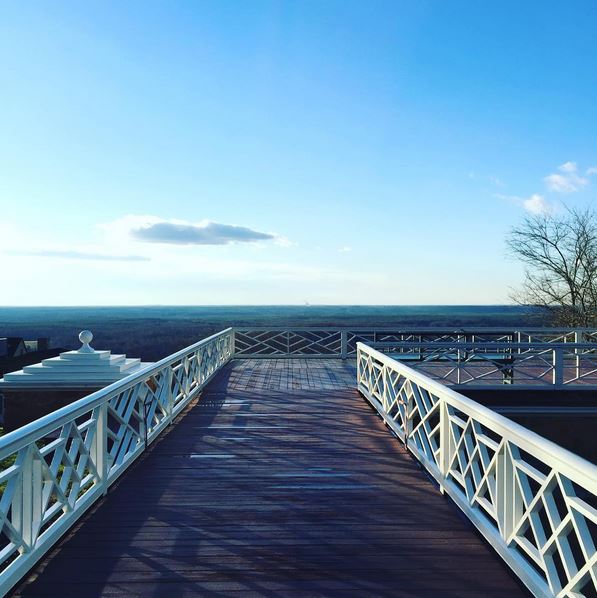Sea View (Spurious Quotation)
Many Monticello residents and visitors have likened the view from Monticello to the ocean, but as of now there is no evidence that Jefferson himself referred to it explicitly as his “sea view,” as some have claimed. Fiske Kimball seems to have been the first to attribute this phrase to Jefferson. The following is a compilation of descriptions of the view which compare it to a body of water. (Relevant phrasing has emphasis added.)
1786 October 12. (Jefferson to Maria Cosway). "And our own dear Monticello, where has nature spread so rich a mantle under the eye? mountains, forests, rocks, rivers. With what majesty do we there ride above the storms! How sublime to look down into the workhouse of nature, to see her clouds, hail, snow, rain, thunder, all fabricated at our feet! And the glorious Sun, when rising as if out of a distant water, just gilding the tops of the mountains, and giving life to all nature!"[1]
1809 July 29-August 2. (Margaret Bayard Smith). “I rose the morning after my arrival very early & went out on the terrace, to contemplate scenery, which to me was so novel.—The space between Montecello and the Allegany, from sixty to eighty miles, was covered with a thick fog, which had the appearance of the ocean & was unbroken except where wood cover’d hills rose above the plain & looked like islands.—As the sun rose, the fog was broken & exhibited the most various & fantastic forms, lakes, rivers, bays, & as it ascended, it hung in white fleecy clouds on the sides of the mountains; An hour afterwards you would scarcely believe it was the same scene you looked on.”[2]
1820-1829. (Charlottesville Central Gazette). “to the right the eye ranged over an expanse of forty miles, and was limited by the verge of the horizon, which resembled that of the ocean…”[3]
1853 January 8. “The distant and detached pinnacle of Willis’s Mountain—which alone, some fifty miles off, due south, cuts, with its singularly sharp cone, the otherwise unbroken line of the sea-like horizon—is the object on which is chiefly exhibited the optical illusion in question.”[4]
1858. (Henry S. Randall). “The view from Monticello is superb. On the west, the already described valley between the Northwest Range and the Blue Ridge, lies stretched out like a map under the feet. On the east, the eye sweeps to the limits of its vision over that great plain which constitutes the sea-margin of the United States from New England to Mexico. From this vast and somber sea of verdure,* there rises but one eminence high enough to break the level of half of the entire horizon seen from Monticello. This is Willis’s Mountain, forty miles distant from the latter, and directly south of it.”[5]
1924. (Fiske Kimball). “From Monticello itself there unrolls on the west a mountain panorama of the Blue Ridge scarcely less magnificent, while to the east stretches the endless plain, his ‘sea view,’ as he called it.”[6]
1942. (Bernard Mayo). “…a house which commanded a magnificent view of the Blue Ridge Mountains to the west, the hamlet of Charlottesville in the valley immediately below, and on the east a stretch of red-clay farmlands which Jefferson called his sea view.”[7]
Sources consulted:
- Founders Online
- Retirement papers
- Quotes & Family Letters
- Google Books
- American Broadsides and Ephemera - “sea view” AND Jefferson, “sea view” AND Monticello
- Gale News Vault - “sea view” AND Jefferson, “sea view” AND Monticello
- Sabin Americana
- America’s Historical Imprints
- America’s Historical Newspapers
- American Periodicals Series
- Anna Berkes, 2/11/2015
References
- ^ Thomas Jefferson to Maria Cosway, October 12, 1786, in PTJ, 10:447. Transcription available at Founders Online.
- ^ Margaret Bayard Smith’s Account of a Visit to Monticello, [29 July–2 August 1809], in PTJ:RS, 1:388. Transcription available at Founders Online.
- ^ Charlottesville Central Gazette, quoted in Kat Imhoff, “The Importance of Place: Viewshed Protection at Monticello,” March 2006. Another source suggests this came from the August 25, 1820 issue, which is no longer extant and cannot be confirmed.
- ^ “Il Segretario” [E. W. Johnston], “The Great Conversationists. Number Four. Jefferson – The Sage of Monticello.” New-York Daily Times, January 8, 1853.
- ^ Henry S. Randall, The Life of Thomas Jefferson (New York: Derby & Jackson, 1858), III: 338-339.
- ^ Fiske Kimball, “Monticello,” Journal of the American Institute of Architects 12 (1924): 175. Reprinted in Merrill Peterson, Visitors to Monticello (Charlottesville, VA: University Press of Virginia, 1989), 188-92.
- ^ Bernard Mayo, ed., Jefferson Himself: The Personal Narrative of a Many-Sided American (Boston: Houghton Mifflin, 1942), 23.
